formerly eScholarship Editions


|
|
|
|
Your request for similar items found 20 book(s). | Modify Search | Displaying 1 - 20 of 20 book(s) | |
| 1. | 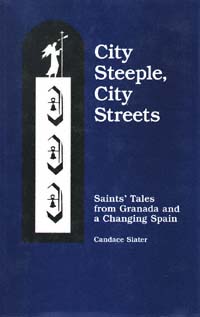 | Title: City steeple, city streets: saints' tales from Granada and a changing Spain Author: Slater, Candace Published: University of California Press, 1990 Subjects: Anthropology | Folklore and Mythology | Literary Theory and Criticism | European Literature Publisher's Description: Candace Slater's new book focuses on narratives concerning Fray Leopoldo de Alpandeire (1864-1956), a Capuchin friar from Granada and probably the most popular nonconsecrated saint today in all of Spain. In tracing the emergence of a group of contemporary legends about Fray Leopoldo, Slater discusses both the stories she tape-recorded in the streets of Granada and the friar's official biography. She underscores the essential pluralism of the tales, their undercurrent of resistance to institutional authority, and their deep concern for the relationship between past and present. Bearing witness to the subtlety and resilience of even the most apparently conservative folk-literary forms, these stories are not only about the role of saints and miracles in an increasingly secular and industrial society but, first and foremost, also about the legacy of the Franco years. [brief] Similar Items |
| 2. | 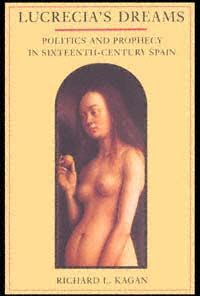 | Title: Lucrecia's dreams: politics and prophecy in sixteenth-century Spain Author: Kagan, Richard L 1943- Published: University of California Press, 1990 Subjects: History | Renaissance History | Women's Studies | Gender Studies Publisher's Description: Branded by the Spanish Inquisition as an "evil dreamer," a "notorious mother of prophets," the teenager Lucrecia de León had hundreds of bleak but richly imaginative dreams of Spain's future that became the stuff of political controversy and scandal. Based upon surviving transcripts of her dreams and on the voluminous records of her trial before the Inquisition, Lucrecia's Dreams traces the complex personal and political ramifications of Lucrecia's prophetic career. This hitherto unexamined episode in Spanish history sheds new light on the history of women as well as on the history of dream interpretation.Charlatan or clairvoyant, sinner or saint, Lucrecia was transformed by her dreams into a cause celébre , the rebellious counterpart to that other extraordinary woman of Golden Age Spain, St. Theresa of Jesus. Her supporters viewed her as a divinely inspired seer who exposed the personal and political shortcomings of Philip II of Spain. In examining the relation of dreams and prophecy to politics, Richard Kagan pays particular attention to the activities of the streetcorner prophets and female seers who formed the political underworld of sixteenth-century Spain. [brief] Similar Items |
| 3. | 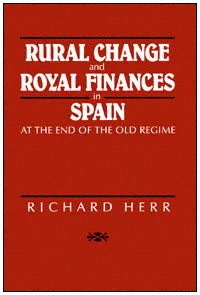 | Title: Rural change and royal finances in Spain at the end of the old regime Author: Herr, Richard Published: University of California Press, 1989 Subjects: History | European History Similar Items |
| 4. | 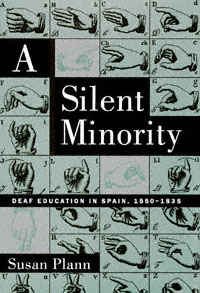 | Title: A silent minority: deaf education in Spain, 1550-1835 Author: Plann, Susan Published: University of California Press, 1997 Subjects: History | Language and Linguistics | Medieval History | European History | Education | European Studies | Medieval Studies | Cultural Anthropology | Cultural Anthropology Publisher's Description: This timely, important, and frequently dramatic story takes place in Spain, for the simple reason that Spain is where language was first systematically taught to the deaf. Instruction is thought to have begun in the mid-sixteenth century in Spanish monastic communities, where the monks under vows of silence employed a well-established system of signed communications. Early in the 1600s, deaf education entered the domain of private tutors, laymen with no use for manual signs who advocated oral instruction for their pupils. Deaf children were taught to speak and lip-read, and this form of deaf education, which has been the subject of controversy ever since, spread from Spain throughout the world.Plann shows how changing conceptions of deafness and language constantly influenced deaf instruction. Nineteenth-century advances brought new opportunities for deaf students, but at the end of what she calls the preprofessional era of deaf education, deaf people were disempowered because they were barred from the teaching profession. The Spanish deaf community to this day shows the effects of the exclusion of deaf teachers for the deaf.The questions raised by Plann's narrative extend well beyond the history of deaf education in Spain: they apply to other minority communities and deaf cultures around the world. At issue are the place of minority communities within the larger society and, ultimately, our tolerance for human diversity and cultural pluralism. [brief] Similar Items |
| 5. | 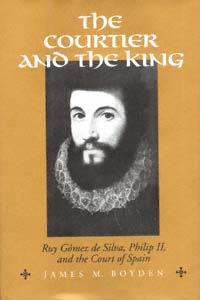 | Title: The courtier and the King: Ruy Gómez de Silva, Philip II, and the court of Spain Author: Boyden, James M 1954- Published: University of California Press, 1995 Subjects: History | European History | Autobiographies and Biographies Publisher's Description: Ruy Gómez de Silva, or the prince of Eboli, was one of the central figures at the court of Spain in the sixteenth century. Thanks to his oily affability, social grace, and an uncanny knack for anticipating and catering to the desires of his prince, he rose from obscurity to become the favorite and chief minister of Philip II.From the scattered surviving sources James Boyden weaves a vivid, compelling narrative: one that breathes life not only into Ruy Gómez, but into the court, the era, and the enigmatic character of Phillip II as well. Elegantly written and highly readable, this book discovers in the career of Gómez the techniques, aspirations, and mentality of an accomplished courtier in the age of Castiglione. [brief] Similar Items |
| 6. | 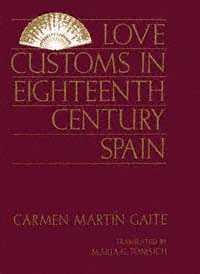 | Title: Love customs in eighteenth-century Spain Author: Martín Gaite, Carmen Published: University of California Press, 1991 Subjects: History | European History | Gender Studies Similar Items |
| 7. | 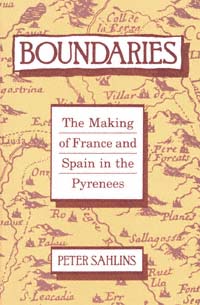 | Title: Boundaries: the making of France and Spain in the Pyrenees Author: Sahlins, Peter Published: University of California Press, 1989 Subjects: History | Anthropology | European History | Geography | French Studies Similar Items |
| 8. | 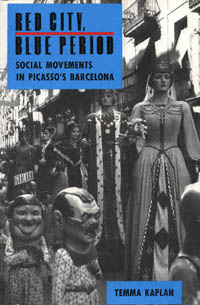 | Title: Red city, blue period: social movements in Picasso's Barcelona Author: Kaplan, Temma 1942- Published: University of California Press, 1992 Subjects: History | Art | European History | Cultural Anthropology | Gender Studies | Art History Publisher's Description: In Red City, Blue Period , Kaplan combines the methods of anthropology and the new cultural history to examine the civic culture of Barcelona between 1888 and 1939. She analyzes the peculiar sense of solidarity the citizens forged and explains why shared experiences of civic culture and pageantry sometimes galvanized resistance to authoritarian national governments but could not always overcome local class and gender struggles. She sheds light on the process by which principles of regional freedom and economic equity developed and changed in a city long known for its commitment to human dignity and artistic achievement.Although scholars increasingly recognize the relationship between so-called high art and popular culture, little has been done to explain what opens the eyes of artists to folk figures and religious art. Kaplan shows how artists like Picasso and Joan Miró, playwright Santiago Russinyol, the cellist Pablo Casals, and the architect Antonio Gaudí, as well as anarchists and other political activists, both shaped and were influenced by the artistic and political culture of Barcelona. [brief] Similar Items |
| 9. | 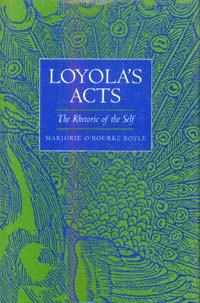 | Title: Loyola's acts: the rhetoric of the self Author: Boyle, Marjorie O'Rourke 1943- Published: University of California Press, 1997 Subjects: Literature | Renaissance History | Christianity | Rhetoric | Art History | Medieval History Publisher's Description: This revisionist view of Ignatius Loyola argues that his "autobiography" - until now taken to be a literal, documentary account - is in reality a work of rhetoric, a moral narrative that exploits the techniques of fiction. In radically reinterpreting this canonical text, our main source of information about the founder of the largest and most powerful religious order in Roman Catholicism, Boyle paints a vivid picture of Loyola's world. She surveys rhetorical and artistic theory, religious iconography, everyday custom, and an astonishing array of scenes and subjects: from curiosity, to codes of honor, to the holy places of Spain, to the significance of apparitions and flying serpents.Written in the tradition of Renaissance studies on individualism, Loyola's Acts engages current interest in autobiography and in the history of private life. The book also provides a powerful heuristic for interpreting a wide range of texts of the Christian tradition. Finally, this secular treatment of a canonized saint provides revealing insights into how a prestigious sixteenth-century figure like Loyola understood himself. [brief] Similar Items |
| 10. | 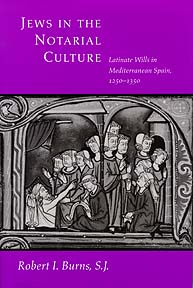 | Title: Jews in the notarial culture: Latinate wills in Mediterranean Spain, 1250-1350 Author: Burns, Robert Ignatius Published: University of California Press, 1996 Subjects: Medieval Studies | Judaism | Jewish Studies | European History | Law | Medieval History Publisher's Description: In the rapidly transforming world of thirteenth-century Mediterranean Spain, the all-purpose scribe and contract lawyer known as the notary became a familiar figure. Most legal transactions of the Roman Law Renaissance were framed in this functionary's notoriously hasty shorthand. Notarial archives, then, offer a remarkable window on the daily life of this pluri-ethnic society. Robert I. Burns brings together the testimony of a multitude of documents, and transcribes in full nearly fifty will-related charters prepared by notaries, to give a never-before-seen view of Jewish society in that place and time.Wills can display the religious conscience, ethical institutions, social mobility, and property dynamics of whole groups or regions. Even a single testament allows a glimpse into the testator's family and into the life and times of the living person. Burns devotes special attention to women in wills and to women's wills, extracting rich information on medieval women and gender relationships.While learning much about the role of kings and courts and the dynamics of Christian-Jewish relations, the reader also gains rare insights into a unique Jewish community. [brief] Similar Items |
| 11. | 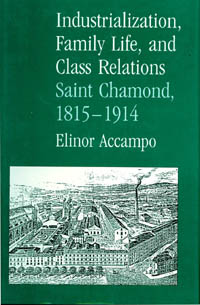 | Title: Industrialization, family life, and class relations: Saint Chamond, 1815-1914 Author: Accampo, Elinor Ann Published: University of California Press, 1989 Subjects: History | European History | Women's Studies Publisher's Description: In this provocative study, Elinor Accampo explores the interrelationship between the structure of work and strategies of family formation in Saint Chamond, a French city that underwent intensive industrialization during the nineteenth century. Through a detailed analysis of fertility, mortality, marriages, and migration, the author analyzes the ways in which the family responded to changes in the organization of work. In the first half of the nineteenth century work was in the home, and families tended to be large in order to meet the demand for workers. But by the 1860s the mechanization of labor had begun to separate family life and work life, fundamentally transforming the relationship between work and family and making the survival of the working-class family more difficult. Accampo argues that workers began to have smaller families much earlier than has previously been suggested, and she demonstrates that fertility declined for reasons unique to working-class conditions. This decline in family size, and the context in which it took place, provides fascinating new material for understanding the working class world and the dynamics of class relations. [brief] Similar Items |
| 12. | 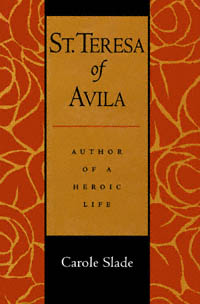 | Title: St. Teresa of Avila: author of a heroic life Author: Slade, Carole Published: University of California Press, 1995 Subjects: Religion | Christianity | Women's Studies | Autobiographies and Biographies | Renaissance History Publisher's Description: With few exceptions, representations of Renaissance women were created by men. The Spanish saint, Teresa of Avila (1515-1582), who chose to represent herself, was one of those exceptions. What prompted her to write Book of Her Life, Interior Castle , and other works? What does the self-portrait of this sixteenth-century nun, mystic, and founder of convents reveal about its author, the church, state, and role of women? St. Teresa of Avila , an innovative analysis of Teresa's autobiographical writings, explores these and many other questions. Bringing to bear a knowledge of Inquisition studies, theory of autobiography, scriptural hermeneutics, and hagiography, Carole Slade defines Teresa's writings as a project of self-interpretation undertaken mainly as the result of the perceived, later realized, threat of an accusation of heresy. Being female and of paternal Jewish ancestry, Teresa was vulnerable to such a charge.Teresa's writing project presented her with serious difficulties. Judicial confession, her prescribed genre, presumed the writer's guilt, while the subordinate female script precluded a defense against the suspicion that her mystical experiences came from the devil. Through careful textual analysis, Slade demonstrates that Teresa exploited the nuances of numerous genres - hagiography, New World chronicle, mystical theological treatise, and early novel - to create an innocent textual persona and depict herself in heroic terms.A signal contribution to our understanding of Teresa's rhetorical and literary talent and life circumstances, this book will engage readers across a broad range of disciplines. [brief] Similar Items |
| 13. | 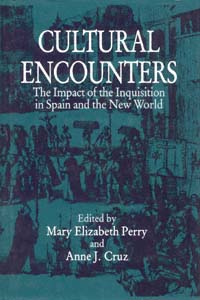 | Title: Cultural encounters: the impact of the Inquisition in Spain and the New World Author: Perry, Mary Elizabeth 1937- Published: University of California Press, 1991 Subjects: History | Anthropology | European History | Religion | Renaissance History Publisher's Description: More than just an expression of religious authority or an instrument of social control, the Inquisition was an arena where cultures met and clashed on both shores of the Atlantic. This pioneering volume examines how cultural identities were maintained despite oppression.Persecuted groups were able to survive the Inquisition by means of diverse strategies - whether Christianized Jews in Spain preserving their experiences in literature, or native American folk healers practicing medical care. These investigations of social resistance and cultural persistence will reinforce the cultural significance of the Inquisition. [brief] Similar Items |
| 14. | 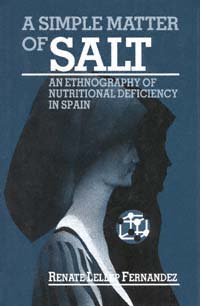 | Title: A simple matter of salt: an ethnography of nutritional deficiency in Spain Author: Fernandez, Renate Lellep Published: University of California Press, 1990 Subjects: Anthropology | Medical Anthropology Similar Items |
| 15. | 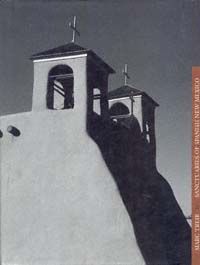 | Title: Sanctuaries of Spanish New Mexico/ Author: Treib, Marc Published: University of California Press, 1993 Subjects: Architecture | Architectural History Publisher's Description: Among the oldest buildings in the United States, the churches of Spanish New Mexico - made of earth, of stone, of wood - are the surprisingly fragile reminders of a unique amalgam of Spanish architectural ideas and native American Pueblo culture. This book surveys the land and rivers, the people and ideas, that led to this compelling religious architecture; it is also a guide to visiting these churches today.In the ninth century the Anasazi, progenitors of the Pueblo peoples, constructed refined architectural complexes at Mesa Verde and Chaco Canyon. Contact with the Spanish in the late 1500s transformed the world of these indigenous peoples, changing their agricultural and living patterns - as well as religious practices. These changes were manifest architecturally in the sanctuaries the Spanish constructed as missions for the Indians or as parish churches for themselves. First built roughly between 1600 and 1829, but continuing to be rebuilt into this century, they were made of the very materials composing the land itself.In Part I, Marc Treib addresses the geographical, anthropological, and architectural aspects of church building in New Mexico and provides background on the church as both an institution and a building type. Part II presents thirty churches in depth and discusses such topics as sitting, construction in adobe and stone, the use of light, ornamentation, and the issues surrounding restoration. Sanctuaries of Spanish New Mexico is the only book in print to include all the major church sites still extant. Richly illustrated, with specially prepared plans of the churches, it will be welcomed by architectural historians and anyone with an interest in the American Southwest. [brief] Similar Items |
| 16. | 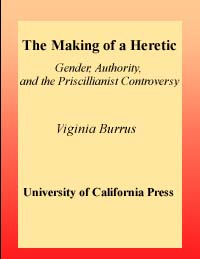 | Title: The making of a heretic: gender, authority, and the Priscillianist controversy Author: Burrus, Virginia Published: University of California Press, 1995 Subjects: Religion | Religion | Christianity | Classical Religions Publisher's Description: Silenced for 1,600 years, the "heretics" speak for themselves in this account of the Priscillianist controversy that began in fourth-century Spain. In a close examination of rediscovered texts, Virginia Burrus provides an unusual opportunity to explore heresy from the point of view of the followers of Priscillian and to reevaluate the reliability of the historical record. Her analysis takes into account the concepts of gender, authority, and public and private space that informed established religion's response to this early Christian movement.Priscillian, who began his career as a lay teacher with particular influence among women, faced charges of heresy along with accusations of sorcery and sexual immorality following his ordination to the episcopacy. He was executed along with several of his followers circa 386. His purportedly "gnostic" doctrines produced controversy and division within the churches of Spain, dissension that continued into the early decades of the fifth century.Burrus's thorough and wide-ranging study enlarges upon previous scholarship, particularly in bringing a feminist perspective to bear on the gendered constructions of religious orthodoxies, making a valuable contribution to the recent commentary that explores new ways of looking at early Christian controversies. [brief] Similar Items |
| 17. | 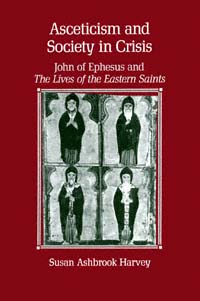 | Title: Asceticism and society in crisis: John of Ephesus and the Lives of the Eastern saints Author: Harvey, Susan Ashbrook Published: University of California Press, 1990 Subjects: Classics | Classical Religions | Classical History Publisher's Description: John of Ephesus traveled throughout the sixth-century Byzantine world in his role as monk, missionary, writer and church leader. In his major work, The Lives of the Eastern Saints , he recorded 58 portraits of monks and nuns he had known, using the literary conventions of hagiography in a strikingly personal way. War, bubonic plague, famine, collective hysteria, and religious persecution were a part of daily life and the background against which asceticism developed an acute meaning for a beleaguered populace. Taking the work of John of Ephesus as her guide, Harvey explores the relationship between asceticism and society in the sixth-century Byzantine East.Concerned above all with the responsibility of the ascetic to lay society, John's writing narrates his experiences in the villages of the Syrian Orient, the deserts of Egypt, and the imperial city of Constantinople. Harvey's work contributes to a new understanding of the social world of the late antique Byzantine East, skillfully examining the character of ascetic practices, the traumatic separation of "Monophysite" churches, the fluctuating roles of women in Syriac Christianity, and the general contribution of hagiography to the study of history. [brief] Similar Items |
| 18. | 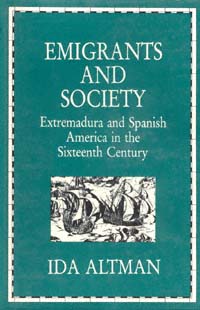 | Title: Emigrants and society: Extremadura and America in the sixteenth century Author: Altman, Ida Published: University of California Press, 1989 Subjects: History | European History | United States History Publisher's Description: The opening of the New World to Spanish settlement had more than the limited impact on individuals and society which scholars have traditionally granted it. Many families and young single people left the neighboring cities of Cáceres and Trujillo in the Extremadura region of southwestern Spain for the Indies. By maintaining ties with home and one another, and sometimes returning, these emigrants developed patterns of involvement that on one level were linked directly to place of origin and on another would come to characterize the emigration movement as a whole. Ida Altman shows that the Indies could and did have a substantial and perceptible effect on local society in Spain, as the New World quickly became an important arena of activity for people seeking new and better opportunities. Her findings suggest interesting conclusions regarding the relationship of sixteenth-century Spanish emigration to the larger movement of people from Europe to the Western Hemisphere in modern times. [brief] Similar Items |
| 19. | 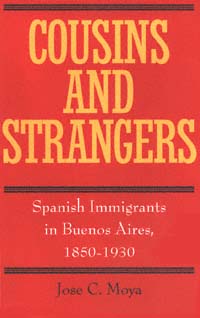 | Title: Cousins and strangers: Spanish immigrants in Buenos Aires, 1850-1930 Author: Moya, Jose C 1952- Published: University of California Press, 1998 Subjects: History | Latin American Studies Publisher's Description: More than four million Spaniards came to the Western Hemisphere between the mid-nineteenth century and the Great Depression. Unlike that of most other Europeans, their major destination was Argentina, not the United States. Studies of these immigrants - mostly laborers and peasants - have been scarce in comparison with studies of other groups of smaller size and lesser influence. Presenting original research within a broad comparative framework, Jose C. Moya fills a considerable gap in our knowledge of immigration to Argentina, one of the world's primary "settler" societies. Moya moves deftly between micro- and macro-analysis to illuminate the immigration phenomenon. A wealth of primary sources culled from dozens of immigrant associations, national and village archives, and interviews with surviving participants in Argentina and Spain inform his discussion of the origins of Spanish immigration, residence patterns, community formation, labor, and cultural cognitive aspects of the immigration process. In addition, he provides valuable material on other immigrant groups in Argentina and gives a balanced critique of major issues in migration studies. [brief] Similar Items |
| 20. | 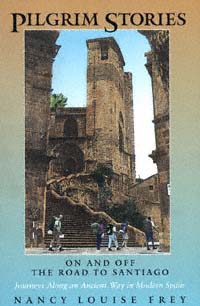 | Title: Pilgrim stories: on and off the road to Santiago Author: Frey, Nancy Louise 1968- Published: University of California Press, 1998 Subjects: Religion | Anthropology | Christianity | European History Publisher's Description: Each year thousands of men and women from more than sixty countries journey by foot and bicycle across northern Spain, following the medieval pilgrimage road known as the Camino de Santiago. Their destination is Santiago de Compostela, where the remains of the apostle James are said to be buried. These modern-day pilgrims and the role of the pilgrimage in their lives are the subject of Nancy Louise Frey's fascinating book.Unlike the religiously-oriented pilgrims who visit Marian shrines such as Lourdes, the modern Road of St. James attracts an ecumenical mix of largely well-educated, urban middle-class participants. Eschewing comfortable methods of travel, they choose physically demanding journeys, some as long as four months, in order to experience nature, enjoy cultural and historical patrimony, renew faith, or cope with personal trauma.Frey's anthropological study focuses on the remarkable reanimation of the Road that has gained momentum since the 1980s. Her intensive fieldwork (including making the pilgrimage several times herself) provides a colorful portrayal of the pilgrimage while revealing a spectrum of hopes, discontents, and desires among its participants, many of whom feel estranged from society. The Camino's physical and mental journey offers them closer community, greater personal knowledge, and links to the past and to nature.But what happens when pilgrims return home? Exploring this crucial question Frey finds that pilgrims often reflect deeply on their lives and some make significant changes: an artistic voice is discovered, a marriage is ended, meaningful work is found. Other pilgrims repeat the pilgrimage or join a pilgrims' association to keep their connection to the Camino alive. And some only remain pilgrims while on the road. In all, Pilgrim Stories is an exceptional prism through which to understand the desires and dissatisfactions of contemporary Western life at the end of the millennium."Feet are touched, discussed, massaged, [and] become signs of a journey well traveled: 'I did it all on foot!' . . . Pilgrims give feet a power and importance not recognized in daily life, as a causeway and direct channel to the road, the past, meaningful relations, nature, and the self." [brief] Similar Items |